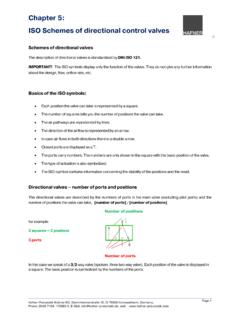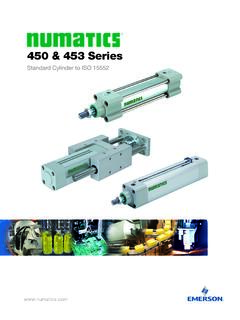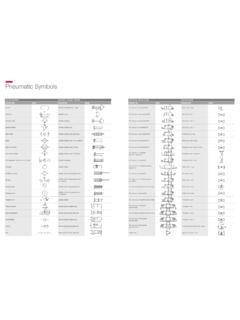Transcription of Chapter 7 - The pneumatic cylinder - part 1
1 Chapter 7: The pneumatic cylinder part 1 Page 1 Hafner-Pneumatik Kr mer KG, Stammheimerstra e 10, D-70806 Kornwestheim, Germany, Phone: 0049-7154-178589-0, E-Mail: web : Right of authorship: the content of the training (wording, drawings, pictures) are owned by the author. Any utilization except for individual use is allowed only after permission of the author. In the earlier chapters we looked at the basic design of a pneumatic system and its most important elements: Air preparation Control valves Flow-regulators Actuators / cylinders Tubes and fittings In this Chapter we will be looking at pneumatic cylinders.
2 Cylinders are the most important means of actuation in pneumatics. The cylinder transfers the energy that is stored in the compressed air into movement. They can be classified by: Design o Cylinders with piston rods o Rodless cylinders o Diaphragm cylinders o Rotary cylinders Movement o Linear o Rotary = turning Function o Single-acting o Double-acting o 3- or 4-positions Cushioning o Adjustable, pneumatic cushioning o Flexible cushioning o Without cushioning There is a very wide variety of pneumatic cylinders. In this training we will only focus the most common ones. Chapter 7: The pneumatic cylinder part 1 Page 2 Hafner-Pneumatik Kr mer KG, Stammheimerstra e 10, D-70806 Kornwestheim, Germany, Phone: 0049-7154-178589-0, E-Mail: web : Cylinders with piston rods Cylinders are available in different types and follow different international standards.
3 Besides the ones that follow standards there are also non-standardized cylinders . Especially before the standardization into DIN/ ISO norms 6431 and 6432, there were numerous cylinder -types offered by different manufacturers. Common standard cylinders are: Mini cartridge cylinders Round cylinders | DIN ISO 6432 Profile cylinders | ISO 15552 | VDMA 24562 | (old norm: DIN ISO 6431) Compact cylinders | ISO 21287 | UNITOP Short stroke cylinders Tie rod cylinders | ISO 15552 Chapter 7: The pneumatic cylinder part 1 Page 3 Hafner-Pneumatik Kr mer KG, Stammheimerstra e 10, D-70806 Kornwestheim, Germany, Phone: 0049-7154-178589-0, E-Mail: web : We will look at the following characteristics: 1.
4 Design 2. Diameter and stroke 3. Movement 4. Number of positions 5. ISO symbols 6. Cushioning Chapter 8 7. Detection of cylinder position (magnetic) Chapter 8 8. Speed control Chapter 8 1. Design of a cylinder Most of the cylinders with a piston rod contain the following parts: a tube that is closed on both ends with a cap and head. Inside the tube seen below a piston rod moves with a drive piston. The movement of the piston is triggered by compressed air, controlled by a directional valve.
5 The direction is defined by the chamber into which compressed air is allowed to flow inside the cylinder . The force is transferred by the piston rod. Components of a piston rod cylinder : Chapter 7: The pneumatic cylinder part 1 Page 4 Hafner-Pneumatik Kr mer KG, Stammheimerstra e 10, D-70806 Kornwestheim, Germany, Phone: 0049-7154-178589-0, E-Mail: web : 2. Diameter and stroke Diameter and stroke are the most important attributes of a cylinder . HAFNER cylinder DIP: DIP 40/320 Type numbering system: DIP type of cylinder / design (DIP = ISO 15552 standard double-acting cylinder adjustable cushioning magnetic piston) 40 diameter of the piston [mm] 320 stroke of the cylinder [mm] The diameter is actually the diameter of the piston.
6 The diameter of the cylinder defines its force relative to the air-pressure. The stroke tells us how many millimetres the piston and therefore the piston rod can travel. Chapter 7: The pneumatic cylinder part 1 Page 5 Hafner-Pneumatik Kr mer KG, Stammheimerstra e 10, D-70806 Kornwestheim, Germany, Phone: 0049-7154-178589-0, E-Mail: web : If the stroke is long, the forces on the bearing between head and piston rod are high. In order to avoid a defect we recommend to select a larger diameter (cylinders with larger piston diameters also offer larger piston rod diameters). In case of very long strokes or radial forces we recommend the use of a guide unit.
7 Pictures: DIP cylinder with assembled guide unit Diameters and strokes are standardized, the most common values are: Piston diameters [mm]: | 8 | 10 | 12 | 16 | 20 | 25 | 32 | 40 | 50 | 63 | 80 | 100 | 125 | 160 | 200 | 250 | 320 | Stroke lengths [mm]: | 5 | 10 | 15 | 20 | 25 | 30 | 40 | 50 | 60 | 80 | 100 | 125 | 160 | 200 | 250 | 320 | 400 | 500 | .. The available diameters depend on, and are limited by, the type / standard. The availability of strokes on the other hand is less limited. The maximum force generated by a cylinder depends on: Operating pressure Diameter of the piston Friction of the inner parts As an example we calculate the force of a cylinder DIL 40/320 at 6 bar.
8 Chapter 7: The pneumatic cylinder part 1 Page 6 Hafner-Pneumatik Kr mer KG, Stammheimerstra e 10, D-70806 Kornwestheim, Germany, Phone: 0049-7154-178589-0, E-Mail: web : Piston diameter: Surface of drive piston: Operating pressure: Calculation of the force: Thus we have a theoretical force of 753,6 N. As a rule of thumb we can deduct 5% for friction. Therefore a cylinder with a piston diameter of 40 mm, and an operating pressure of 6 bar, can exert a force of approx. 716 N. If we divide the force by gravity (9,81 m/s2), we find - in practice - that our cylinder can hold a mass of about 73 kg.
9 CAUTION! We can only hold the weight with this force, we cannot move it yet! If we want to move a weight we have to (again) take gravity into consideration. Only then our cylinder is not only able to hold a weight but to perform work. Chapter 7: The pneumatic cylinder part 1 Page 7 Hafner-Pneumatik Kr mer KG, Stammheimerstra e 10, D-70806 Kornwestheim, Germany, Phone: 0049-7154-178589-0, E-Mail: web : 3. The Movement of a cylinder We call the two end-positions of a cylinder positive / plus and negative / minus positions. Therefore we also call the two chambers inside the cylinder the plus and the minus chamber. Positive movement Negative movement The position where the piston rod is out of the cylinder the furthest possible is called the plus end-position.
10 In order to reach it, the plus chamber needs to be inflated. The minus end-position is positioned on the opposite side; the minus chamber needs to be inflated. The cylinder cannot reach an end-position if the opposite chamber is not fully exhausted! 4. Stable positions of a cylinder We distinguish between single-acting and double-acting cylinders. In single-acting cylinders only one chamber is inflated with compressed air. Therefore work is performed only in one direction by compressed air. For the movement into the opposite direction a mechanic spring is the source of energy. The stroke is limited by the length of the spring.









